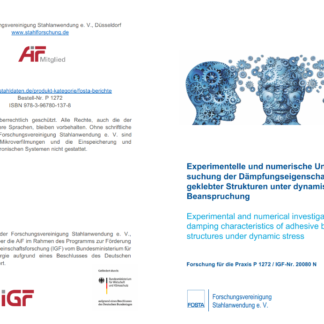Description
P 1272 – Experimental and numerical investigation of the damping characteristics of adhesive bonded structures under dynamic stress
A large number of structures from areas of steel construction, such as bridge structures, supporting structures for wind turbines and mast and observation tower constructions, as well as from areas of (oscillating) mechanical engineering and automotive construction, are exposed to dynamic excitation during their lifetime. These excitations often result from environmental influences from the the regular operation of a machine or an automobile and lead to structural vibrations in the construction, which result in increased mechanical stresses. Adhesives, based on epoxy resins and polyurethanes can be modified in a way that, in addition to excellent strength, they also offer good damping characteristics. The viscoelastic material behavior of the adhesive results in material damping, which contributes to structural damping. So far, however, it has not been clarified how dynamically stressed structures can be optimized with adhesive bonded joints in order to exploit the advantageous damping properties of viscoelastic adhesives in dynamic coordination. Within the framework of the completed research project, the performance of adhesively bonded joints was therefore investigated and modelled with special consideration of the damping properties. Based on mechanical and dynamic characterisation tests, a 2C-PU and a 2C-EP adhesive were selected for further investigations. In the context of vibration stress, there is a need to investigate the damping behaviour for the application areas of steel construction, automotive construction and vibration machinery and plant construction.
Within the framework of the project, a new methodology was developed to take into account damping adhesive layer properties of dynamically stressed structures. The focus is placed on both experimental and numerical identification and characterisation of the damping properties of bonded joints. The development progress achieved can lead to an increase in efficiency and cost-effectiveness in the areas of steel, automotive as well as vibration machines and plant engineering.
The aim of the research project was to develop a concept for the reliable calculation and assessment of the damping properties of dynamically stressed bonded lap and plug-in joints. The concept should be applicable to constructions and structures from the steel, automotive, vibration machine and plant engineering sectors.
The following work was done:
- Characterization and selection of suitable materials (steel and adhesives) as well as bonded connection details from the areas of steel construction, automotive construction, vibration and plant construction.
- Investigation of the damping potential using numerical calculations on realistic structures.
- Identification of relevant material parameters as well as development and validation of material models to describe the damping behavior of the adhesive.
The following results were obtained:
- Quantification of the damping potential of bonded technological and componentlike test specimens.
- Identification of the influence of different geometry and test boundary conditions on the damping properties of the investigated test specimens.
- Successful development and validation of material models of the adhesives: The experimentally determined damping properties can be predicted by numerical simulations.
All research reports in german language only!
Published in:
April 2022
Authors:
J. Damm, M. Albiez, Prof. T. Ummenhofer, J. Göddecke, Prof. G. Meschut, F. Kötz, Prof. A. Matzenmiller


